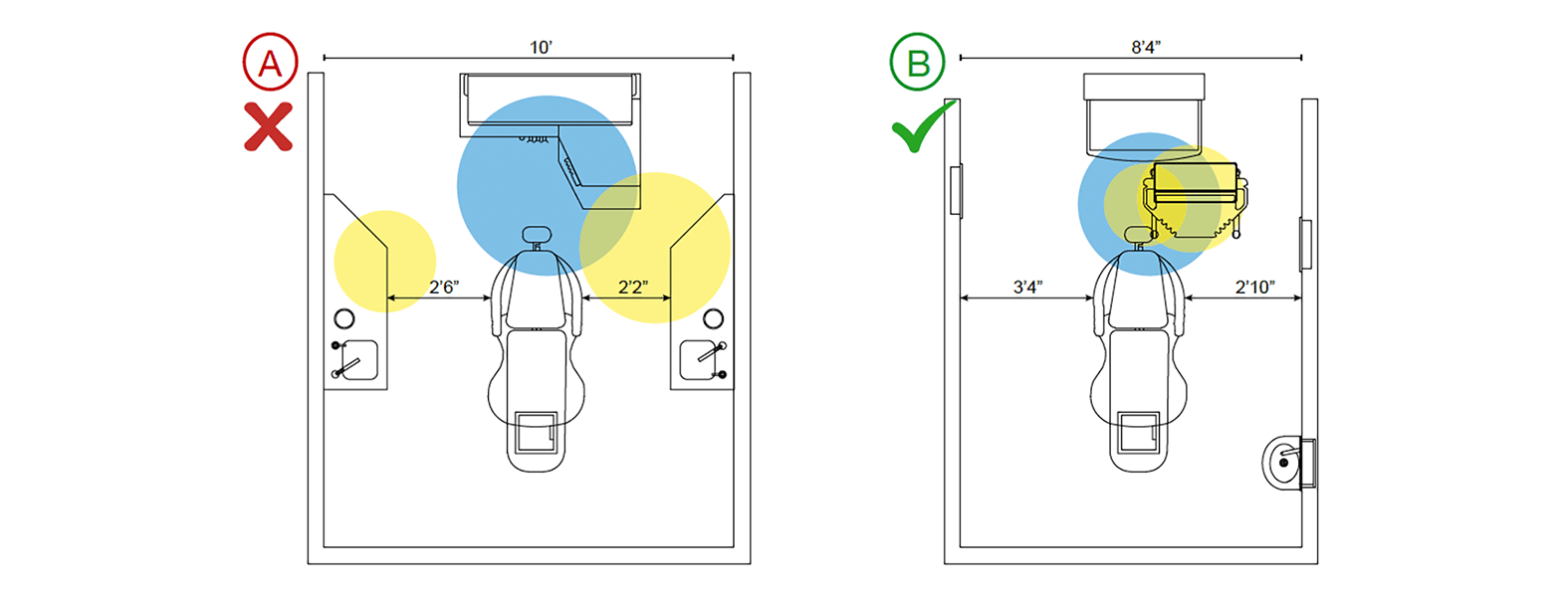
Search for topics or resources
Enter your search below and hit enter or click the search icon.
October 12th, 2023
2 min. read

By The D/E Design Team
The key to creating dental operatories that are space-efficient is to avoid bulky, unnecessary cabinetry, so that the operatory floor is open and uncluttered. This is done largely through consolidation of supplies within arm's reach of the operator and through the use of in-wall cabinetry. Resulting operatories feel spacious while providing enhanced ergonomics for operators, and a sublime and relaxing patient experience. The "scary stuff" is moved out of patient view and the doctor and assistant can efficiently deliver either two or four-handed dentistry.

The doctor and assistant enjoy an ergonomic and efficient consolidation of supplies (at left) while the patient view is relaxing and free of all the "scary stuff" (at right). A TV can easily be mounted on the light above the patient to provide entertainment during the visit.
Having a smaller operatory footprint allows for more operatories within a given space. And less bulky cabinetry means reduced setup costs and less likelihood of out-of-view supplies expiring.
Figure “A” below shows a typical 10 foot wide treatment room. In this layout the clear floor area between the cabinets is actually less than 5 feet wide. This makes mobilization, sedation, in-room checkout and consultation largely impractical. It also feels more congested to the patient.
Figure “B” increases obstruction-free floor width by a foot-and-a-half, while actually reducing overall width of the room. Psychological studies have shown that increasing the volume of clear floorspace makes the room feel much more expansive. As an added benefit, it also allows for better mobilization of technology.

Also note the reduced size of the work area required for treatment. In Figure “A”, both doctor and assistant are forced to reach behind or to the side for supplies, as shown in the shaded areas. In Figure “B”, supplies have been removed from the side-cabinetry and placed near the “zone of production” (i.e., the patient’s mouth). This greatly reduces the range-of-motion required to perform treatment, which eliminates ergonomic stress on the body and significantly enhances production speed.
To illustrate the effect of removing bulky side cabinets, take a look at the 360° image below. Notice the uncluttered patient view and the consolidation of equipment within arm's length of the operators. Click and drag to pan around the room.
Ideally, each of your rooms will be stocked to fully accommodate 90% of the procedures you commonly do in your practice - we call this your "90% Procedure Profile". The materials for less–frequent procedures (e.g., endo, ortho, sedation, surgery, etc.) are available for chairside delivery at a moment’s notice through the use of separate, procedure specific supply tubs and readily deployable mobile carts.
The question then becomes, how much material will “fully accommodate” your core procedures? Knowing that your procedure frequency (and supply use) will vary from week to week, it’s advisable to build in a margin that accommodates spikes in usage – especially in operatories where spikes happen quickly, giving you less time to react. So, while stocking treatment rooms with 7 days of material is generally enough, we recommend that you stock with 10. Similarly, instead of 4-5 weeks in central inventory, we recommend stocking to a full 6. It’s always better to have supplies and not need them than to need supplies and not have them.

A typical 10 operatory office–centric practice. Central sterilization and resupply (highlighted) is an easily accessed focal point of clinical activity. High-tech and/or infrequently used equipment is kept on mobile carts, also centralized (highlighted in blue), for rapid deployment to any location.
We've been designing the best offices across North America for over 25 years. These are office-centric practices that have more, and more efficient, dental operatories along with convenient, centralized, dental resupply. If you would like to see these systems in action in a dental practice near you, send us a quick Spotlight Visit Request and our team will get right back to you.